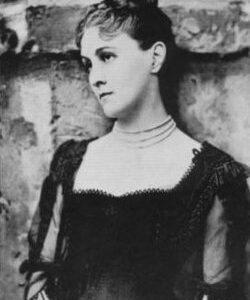HOLY COW! HISTORY: The Star-Crossed Love of Stanny and Sara

Some loves are doomed from the start. The attraction, the desire, the passion are genuine and sincere. But people, timing, and events conspire to make it a stillborn affair forced to remain forever buried in the star-crossed lovers’ hearts.
Tall, beautiful, 21-year-old Sara was a prize catch in New York’s Hudson River blueblood society of 1876. Her family lived in a 40-room mansion. Sara was well-traveled and well-educated, spoke fluent German and French, and carried herself like a queen. Needless to say, she had plenty of suitors.
But Sara fell into a love deeper than a bottomless pit the minute she first saw Stanny. He wasn’t like the genteel admirers swarming around her.
Stanny (short for Stanford) was 22, red-headed with a sweeping mustache and an oversized personality to match. He was an aspiring architect who impressed Sara as witty, kind, and generous. Already a sophisticated collector of expensive art and antiques, his next acquisition would be Sara’s hand in marriage.
There was just one problem, and it was a biggie.
Sara’s father couldn’t stand Stanny. Not a casual dislike, either; he loathed the young man. He found Stanny loud, brash, and tasteless calling him “my red-headed terror,” the personification of the type of man Sara shouldn’t marry.
Sara faced a major dilemma. She worshipped her father; in her eyes, he could do no wrong. Yet she truly loved Stanny, too.
So, the dad did what wealthy Victorian fathers typically did in that situation: He packed up Sara and sent her on a grand tour of Europe. It didn’t work. Sara mooned over Stanny as she moved around the Continent for nine months.
When she returned home still pining for her boyfriend, her father then sent her in the opposite direction—she was hustled off to Hong Kong to stay with relatives.
Sara finally accepted the inevitable. She and Stanny would never live happily ever after together. Stanny was the love of her life, but she simply could not bring herself to defy the father she adored. The relationship ended and the lovers sadly went their separate ways.
Maybe it was a case of “father knows best” because, unknown to anyone, Stanny had a dark secret.
“Stanny” was Stanford White, who went on to become America’s most famous and successful architect in the Victorian era. He designed mansions for millionaires in Newport. He drew plans for impressive churches and massive business buildings in New York City. And in an amazing twist of fate, he even designed the second Madison Square Garden where his hidden secret ultimately led to his very public death.
Stanford White was a sexual predator who preyed on teenage girls. His many victims included Evelyn Nesbit. Stunningly beautiful, she was one of the famous Gibson Girls, an early iteration of the “supermodel.” She eventually married Harry K. Thaw, a Pittsburgh social gadfly said to be worth $40 million (nearly $1 billion today).
But Thaw had issues of his own. He was, to put it charitably, mentally unstable and subject to wild, violent mood swings. Obsessed with his beautiful wife, he decided Stanny must be punished for having violated Evelyn.
On the broiling night of June 25, 1906, Thaw encountered Stanny in Madison Square Garden’s rooftop theater. Screaming either, “You ruined my wife” or “You ruined my life,” (witnesses reported hearing it both ways), he pulled out a gun and shot Stanny dead.
It was a national scandal the newspapers reported in lurid detail. After two trials, Thaw was ordered locked in an insane asylum for life. (His family’s immense wealth helped persuade a judge to release him a few years later.)
And remember Sara? She was 51 when Stanny was murdered. She quietly mourned him for the rest of her life. “Sara never stopped loving Stanford White,” a close relative later said. “He was the only man she ever loved.”
In 1880 at age 26, Sara had wed a 53-year-old wealthy widower. They soon had one child, a son.
Sara’s full name was Sara Ann Delano. Her husband’s name was James Roosevelt.
And the baby’s name was Franklin Delano Roosevelt.
You can’t help wondering who would have guided America out of the Great Depression and through World War II if the star-crossed lovers had changed her father’s mind and been permitted to marry.
On such small slivers do the fate of nations — and in this case, the world — invisibly hang.


